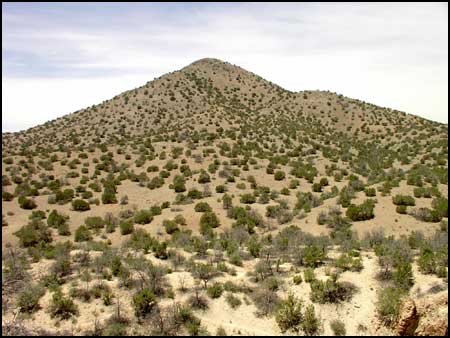 Can You Dig It?
Can You Dig It?By Charles Reuben
shawnee@unm.edu
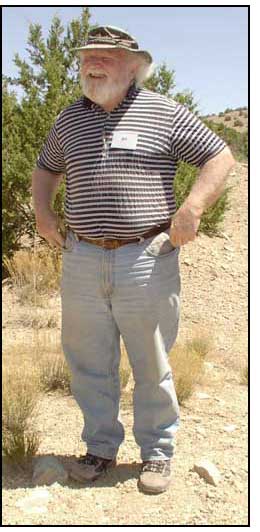 “What do you get when you throw a piano down a mine shaft?” William Baxter asked our group from the University of New Mexico’s Continuing Education.
“What do you get when you throw a piano down a mine shaft?” William Baxter asked our group from the University of New Mexico’s Continuing Education.
We took a moment to ponder his question at the base of a prehistoric turquoise pit outside of Cerrillos, New Mexico, under the blistering sun.
“I dunno,” someone said. “What do you get?”
“A flat minor,” Baxter replied.
If you listen to Baxter and his necdotes long enough you’ll probably begin to conjure up images of rowdy miners sitting around a campfire, eating beans and sardines and drinking Gut Rot. But make no mistake: Beneath Baxter’s crusty old-timer exterior is an encyclopedic knowledge of geology and mining history.
Baxter recently acted as our guide to some extraordinary mining sites in the Cerrillos Hills. Our group consisted mostly of retirees who were participating in an “Ex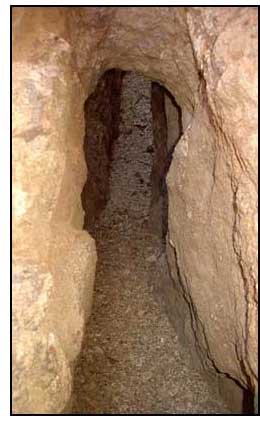 plore New Mexico” field trip. We traveled in three blessedly air-conditioned vans that somehow managed to negotiate crazy roads best traveled by four-wheel drive vehicles. We were permitted to enter into gated, private property and allowed to freely explore the remains of prehistoric and contemporary mining sites.
plore New Mexico” field trip. We traveled in three blessedly air-conditioned vans that somehow managed to negotiate crazy roads best traveled by four-wheel drive vehicles. We were permitted to enter into gated, private property and allowed to freely explore the remains of prehistoric and contemporary mining sites.
Baxter came to Cerrillos, New Mexico in 1997 after running computer networks in San Francisco. Now, about the only thing he boots up are his feet when he prepares to explore the surrounding countryside of Cerrillos, population 200, located 20 miles southwest of Santa Fe and about 40 miles from Albuquerque.
Baxter and his friend Todd Brown are on a mission to educate the public about the historic and environmental importance of this area. Brown, whom Baxter affectionately calls “an old hippy,” lives with his wife Patricia in a 28-room hacienda that he built in 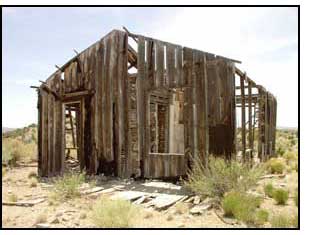 1975. The couple raised six children there.
1975. The couple raised six children there.
Brown’s sprawling hacienda houses the Cerrillos Turquoise Mining Museum, an impressive collection of rocks, gems, minerals, mining equipment, old telephone insulators and, of course, turquoise. “Everything’s for sale,” said Brown as I admired an enormous sheet of mica. A sign in the museum says all the exhibits are self-explanatory and that if you have any questions, to ask up front. Brown also runs a petting zoo where you can feed some goats and a llama.
Most of the miners that used to pick away at the Cerrillos Hills are gone now but there’s probably a lot of lead, silver, galena and turquoise sitting under those mountains. Baxter and Brown would like to see this surrounding, unprotected land placed 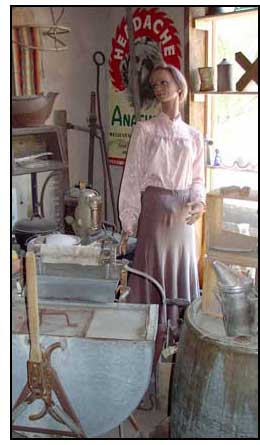 securely into the public’s hands and far away from the reach of corporate mining interests.
securely into the public’s hands and far away from the reach of corporate mining interests.
Indiscriminate mining, both by large and small operations, can be hard on the environment. Not only does it create unsightly holes and gashes in the earth, but it also causes pollution. Waste from a mine (known as tailings) are usually placed in large piles and can, after being exposed to air and water, produce sulfuric acid, mercury and arsenic. Toxic runoff from these tailings can end up in a community’s drinking water and can take decades to be cleaned up, usually at the government’s expense.
It was a pleasure to drive along the rugged roads and although our time was limited, we saw abandoned mines, the ruins of wood-framed housing and unspeakably beautiful landscapes. Seven hundred years of mining may have pockmarked the sun-scorched hillside, but it was never entirely stripped of its beauty.
According to Baxter there is a reason the big m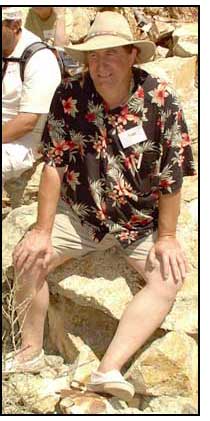 ining companies never quite destroyed this area in search of precious metals and minerals, like they have in many other parts of the country. Baxter said that “small, localized mineralization” kept this site from becoming strip-mined.
ining companies never quite destroyed this area in search of precious metals and minerals, like they have in many other parts of the country. Baxter said that “small, localized mineralization” kept this site from becoming strip-mined.
Modern commercial mining interests now use subatomic, underground explosions to “rubbleize” the environment. In 1977 the now-defunct Occidental Minerals Corporation came to Cerrillos looking for copper using “in-place acid leach mining.” Fortunately the company wasn’t able to find much copper so they eventually left town, leaving 500 unsightly test holes in its wake.
Recent evidence suggests that the Native Americans began mining for turquoise at this location at around 700 AD. The Spanish regarded the stone as being worthless until it caught the eye of European nobility. During the late 1800’s the price of turquoise actually exceeded the price of gold. The American Turquoise Company (whose principle stockholders were New York’s Tiffany & Company) bought up some of the best mines in the area. In 1912 the market for turquoise collapsed.
If Baxter and the residents of Cerrillos have anything to say about it, the land is going to stay out of the hands of the big mining companies. 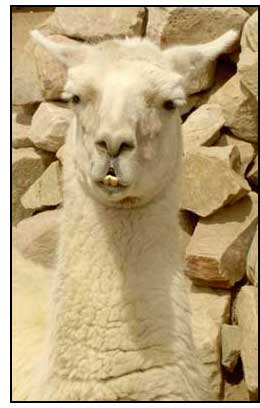 The little town of Cerrillos would like to see these historic lands given to the public for their future enjoyment and recreation.
The little town of Cerrillos would like to see these historic lands given to the public for their future enjoyment and recreation.
In the 1960s the National Park Service unsuccessfully proposed that the Cerrillos Mining District be declared an Historic Landmark. In 1970 the Museum of New Mexico succeeded in getting the state to declare this area a National Historic District. There are abundant reasons why this area this area should be further protected by some sort of the Federal Government.
All is not lost. The Cerrillos Hills Historic Park has been established under the auspices of the Santa Fe County Open Spaces and Trails Department and includes 1100 acres of land that is currently open to the public. We drove through this area in order to reach the private mining sites but did not explore it. Information about it can be gleaned from their fascinating website located at http://www.cerrilloshills.org/
As nice as the Cerrillos Hills Historic Park appears to be, it doesn’t contain the prehistoric mine sites and abandoned camps that we were privileged to see. Baxter and Brown are fighting an uphill battle to change all that and they appear to be making progress.
This is not an easy task. According to Baxter, the laws that govern mining haven’t changed much since the Mining Law of 1872 was passed. According to a group called the Westerners for Responsible Mining, 270 million acres of federal land (1/4 of all the land in the United States) is open to mineral exploration.
At one time the landscape was crawling with prospectors, digging holes in the ground, hoping to discover a vein or a lode of precious rock or metal that would make them rich. Each prospector registered a legal claim on some part of the mountain and every blue or gold fleck they discovered added 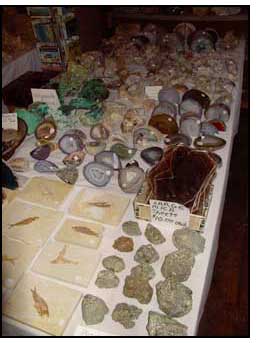 fuel to the fires of greed that burned in their belly.
fuel to the fires of greed that burned in their belly.
There were, in fact, so many miners in this area that they called a prominent mountain in the mining area “Grand Central” and I was amazed to learn that some crazy fool dug 3,000 feet into it.
Sometimes the miner’s faith was deliberately misdirected. A competing miner might sprinkle fine pieces of turquoise or silver in the barren shaft of another, just to keep him digging in the wrong direction.
And sometimes the faith and the bodies of miners were crushed by tons of rock when they accidentally undermined a critical supporting structure. And if they were digging alone, they’re fate was never known.
Abandoned mines can actually benefit the environment if they are not backfilled with dirt, as has been the conventional practice. Monitored, vandal-proof gates placed at the mouth of old mines can provide a haven for many bat species. Encouraging the proliferation of bats is probably a good thing, especially the way they are (according to media reports) being sliced and diced by the new generation of electric-generating wind turbines.
A visit to Cerrillos, New Mexico and its defunct mine operations will definitely get you thinking about where all that gold, silver, turquoise, gas, oil and minerals came from.
It was not my purpose in this story to promote the virtue of small mining interests over big ones. Big mining operations can very often be more responsible in cleaning up their mess than small ones because they will be around to be sued. “Small mine operations and their tailings litter southern Colorado,” a friend of mine pointed out.
Perhaps in the end everybody must be held responsible for cleaning up the mess that they make on public property.
Thank you for visiting Chucksville.
(Please note: I just received an e-mail from Todd Brown who writes, "The Cerrillos Hills Historic Park has changed hands and is now our newest New Mexico State Park." More information can be found by pressing this link. Updated: July 13, 2010)
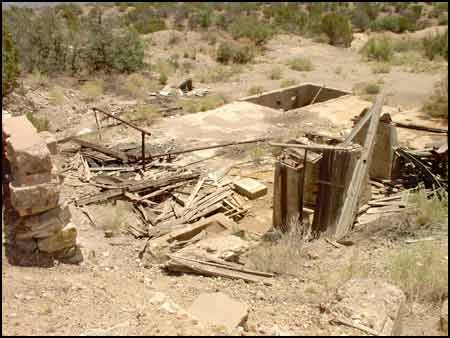
|
|
|
|


